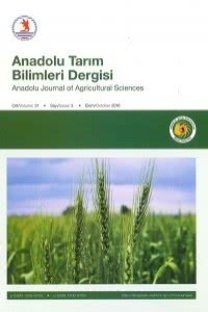Toprak biliminde kızıl ötesi spektrometrenin potansiyel kullanımı
hassas tarım, toprak analizleri, toprak kimyasal özellikleri, toprak organik materyali, toprak pH'sı, toprak fiziksel özellikleri, toprak bilimi, mineral bilimi, kızılötesi spektroskopisi, değişebilir katyonlar, kil mineralleri, katyon değiştirme kapasitesi, karbon tutulması, analitik yöntemler
The potential use of infrared spectroscopy in soil science
precision agriculture, soil analysis, soil chemical properties, soil organic matter, soil pH, soil physical properties, soil science, mineralogy, infrared spectroscopy, exchangeable cations, clay minerals, cation exchange capacity, carbon sequestration, analytical methods,
___
- Anonim. 2007. Rapid Soil Analysis Services. www.clw.csiro.au/services/ 19 şubat 2007.
- Ben-Dor, E., Banin, A., 1995. Near-infrared analysis as a rapid method to simultaneously evaluate several soil properties. Soil Science Society of America Journal. 59:364– 372.
- Bogrekci I, Lee W.S. , 2005. Improving phosphorus sensing by eliminating soil particle size effect in spectral measurement Source: Transactions of the ASAE 48,5: 1971-1978.
- Bogrekci, I., Lee, W.S., 2006. Effects of soil moisture content on absorbance spectra of sandy soils in sensing phosphorus concentrations using UV-VIS-NIR. Spectroscopy. Transactions of the ASAE 49,4: 1175- 1180.
- Brown, D.J., K.D. Shepherd, M.G. Walsh, M. D. Mays, T.G. Reinsch. 2006. Global soil characterization with VNIR diffuse reflectance spectroscopy Geoderma 132:273–290.
- Chang, C.-W., Laird, D.A., Mausbach, M.J., Hurburgh Jr., C.R., 2001. Near-infrared reflectance spectroscopy— principal components regression analysis of soil properties. Soil Sci. Soc. of Am. J. 65:480–490.
- Cohen, M.J., J.P. Prenger, W.F. DeBusk. 2005. Visible-Near Infrared Reflectance Spectroscopy for Rapid, Nondestructive Assessment of Wetland Soil Quality J. Environ. Qual. 34:1422-1434.
- Cozzolino, D., Moron, A., 2003. The potential of nearinfrared reflectance spectroscopy to analyze soil chemical and physical characteristics. J. Agric. Sci. 140:65–71.
- Daniel, K.W., Tripathi, N.K., Honda, K., 2003. Artificial neural network analysis of laboratory and in situ spectra for the estimation of macronutrients in soils of Lop Buri (Thailand).Australian Journal of Soil Research 41:47–59.
- Dematte, J.A.M., Campos, R.C., Alves, M.C., Fiorio, P.R., Nanni, M.R.,2004. Visible-NIR reflectance for soil evaluation. Geoderma 121:95-112.
- Gündüz, T. 2002. İnstrumental Analiz. 6. Baskı. Bilge Yayıncılık. Ankara.
- Hummel, J.W., K.A., Sudduth, S.E., Hollinger. 2001. Soil moisture and organic matter prediction of surface and subsurface soils using an NIR soil sensor. Computers and Electronics in Agri. 32:149–165
- Islam, K., A. McBratney, B. Singh. 2005. Rapid estimation of soil variability from the convex hull biplot area of topsoil ultra-violet, visible and near-infrared diffuse reflectance spectra. Geoderma 128:249–257.
- Islam, K., B. Singh, A. McBratney, 2003. Simultaneous estimation of various soil properties by ultra-violet, visible and near-infrared reflectance spectroscopy. Australian Journal of Soil Research 41:1101–1114.
- Kılıç, E., Köseoğlu, F., Yılmaz, H. (Çeviri Editörleri). 1998. Enstrümental Analiz İlkeleri. Bilim Yayıncılık. Ankara.
- Lobell, D.B., G. Asner. 2002. Moisture effect on soil reflectance. Soil Sci. Soc. Am. J. 66 :722-725.
- Madari, B.E., J.B. Reeves III, P.L.O.A. Machado, C.L. Guimares, E. Torres, G.W. McCarthy. 2006. Mid- and Near infrared spectroscopic assessment of soil compositional parameters and structural indices in two Ferrasols. Geoderma. 136:1-2, 245-259.
- McBratney, A.B., B. Minasny, R. Viscarra Rossel. 2006. Spectral soil analysis and inference systems: A powerful combination for solving the soil data crisis Geoderma. 136, 1-2:272-278.
- McCarty, G.W., J.B. Reeves III, V.B. Reeves, R.F. Follet, J.M. Kimble. 2002. Mid-infrared and near-infrared diffuse reflectance spectroscopy for soil carbon measurement. Soil Sci. Soc. Am. J. 66:640–646.
- Mouazen, A.M., R. Karoui, J. De Baerdemaeker, H. Ramon.2005. Classification of soil texture classes by using soil visual near infrared spectroscopy and factorial discriminate analysis techniques. J. Near Infrared Spectroscopy. 13:231-240.
- Mouazen, A.M., R. Karoui, J. De Baerdemaeker, H. Ramon. 2006. Characterization of Soil Water Content Using Measured Visible and Near Infrared Spectra. Soil Sci. Soc. of Am. J. 70:1295-1302.
- Mouazen, A.M., M.R. Maleki, J. De Baerdemaeker, H. Ramon. 2007. On-line measurement of some selected soil properties using a VIS-NIR sensor. Soil & Tillage Research. 93:1,13-27.
- Pasquini, C., 2003. Near infrared spectroscopy: Fundamentals, practical aspects and analytical applications. J. Braz. Chem. Soc. Vol. 14:2, 198-219.
- Reeves III J.B., G.W. McCarty, R.F. Follett, J.M. Kimble. 2006. The potential of spectropic methods for rapid analysis of soil samples. Carbon Sequestration in Soils of Latin America. Harword Press Publ. Inc. p. 423-442.
- Odlare, M., Svensson, K., Pell, M., 2005. Near infrared reflectance spectroscopy for assessment of spatial soil variation in an agricultural field. Geoderma 126:193– 202.
- Sørensen, L.K., S.Dalsgaard, 2005. Determination of Clay and Other Soil Properties by Near Infrared Spectroscopy Soil Science Society of America Journal. 69:159-167.
- Shepherd, K.D., Walsh, M.G., 2002. Development of reflectance spectral libraries for characterization of soil properties. Soil Sci. Soc. of Am. J. 66:988– 998.
- Shepherd, K.D., Walsh, M.G., 2004. Diffuse reflectance spectroscopy for rapid soil analysis. In: Lal, Rattan (Ed.), Encyclopedia of Soil Science. Published online by Marcel Dekker 04/26/2004.
- http://www.dekker.com/servlet/product/DOI/ 101081EESS120017436. [Ulaşım 30 Haziran 2006].
- Vågen, T.-G., K. D. Shepherd, M.G. Walsh. 2006. Sensing landscape level change in soil fertility following deforestation and conversion in the highlands of Madagascar using Vis-NIR spectroscopy Geoderma 133:281–294.
- Velasqueza, E., Lavellea, P., Barrios, E., Joffre, R., Reversat, F. 2005. Evaluating soil quality in tropical agroecosystems of Colombia using NIRS Soil Biology & Biochemistry 37: 889–898.
- Viscarra Rossel, R.A., D.J.J. Walvoort, A.B. McBratney, L.J. Janik, J.O. Skjemstad 2006. Visible, near infrared, mid infrared or combined diffuse reflectance spectroscopy for simultaneous assessment of various soil properties Geoderma 131:1-2, 59-75.
- Wetzel, D.I., 1983. Infrared reflectance analysis: sleeper among spectroscopic techniques. Analytical Chemistry 55:1165–1176.
- ISSN: 1300-2988
- Yayın Aralığı: Yılda 3 Sayı
- Başlangıç: 2018
Sezgin UZUN, AHMET BALKAYA, DİLEK KANDEMİR
Ektomikorizanın tarım ve ormancılık bakımından önemi
Sebzelerde etilenin önemi ve 1-metilsiklopropen (1-MCP)'in kullanımı
Permütasyon testlerinin doğrusal regresyonda kullanılabilirliğinin irdelenmesi
Yenilebilir ektomikorizal mantarların yetiştiriciliği ve bu konuda yapılan çalışmalar
Ahmet KORKMAZ, Havva Sera ŞENDEMİRCİ
Heat-emission characteristics of some energy plants
A. K Gürkan GÜRDİL, K. Çağatay SELVİ, Petr JEVİC, Jan MALAT'AK, Yunus PINAR
Toprak biliminde kızıl ötesi spektrometrenin potansiyel kullanımı
HİKMET GÜNAL, SABİT ERŞAHİN, Fevzi AKBAŞ, MESUT BUDAK
Meyve ağaçlarında bodurluk mekanizması
MEHMET ARİF ÖZYAZICI, Osman ÖZDEMİR, GÜLEN ÖZYAZICI, Sevinç ALPAY
